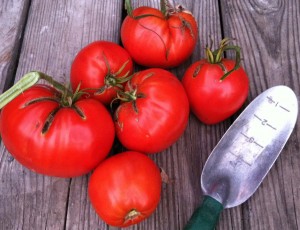Recently, Jan and I were asked to write a column on kitchen gardening for our local on-line newspaper, AnnArbor.com. For the most part, we intend to cross-post articles but our first post was a getting-to-know-you piece that’s exclusive to AnnArbor.com. On Tuesday, we cross-posted about ichiban eggplant and we got a question by email that’s good enough to make a whole post about. One reader noted that we referred to eggplant as both a fruit and a vegetable and wanted to know, basically, what’s up with that?
Fruits vs. vegetables: It’s a great debate, I’ve come to appreciate, joined in by cooks and diners and gardeners and botanists and I even think the U.S. government has an opinion about it because of tariffs. I do not pretend to resolve the matter, only to add my voice to the great conversation. PLEASE, feel free to add your voice in the comments.
My favorite definition of a vegetable is “food your kids won’t eat.” I am only partially joking but what I like about this approach is that it accents preparation and reception. I’ve eaten sweet potatoes that were clearly a “vegetable” – roasted split down the middle with butter and garlic as a side to tandoori chicken- but also baked into a pie for dessert. One of Jan’s favorite salads blends garden greens with walnuts, crumbled bleu cheese… and dried cherries. I suspect many omnivores have trouble grokking vegetarianism because they’ve implicitly defined “vegetable” as a side-dish. To me, vegetables are the broad category of garden products primarily when considered as food. When I tell folks I’m a vegetable gardener, they know I’m growing things to eat, though I prefer the term “kitchen garden” since I feel it allows me to tuck in a few flowers.
But personally when I use the word “fruit” I’m indicating a specific part of plant anatomy. A fruit – to me – is a fleshy seed container. This means that tomatoes are fruits as are apples, as well as rose hips – though some rose varieties have a fleshier fruit than others. My beloved jalapeno peppers are fruits as are pumpkins and squash. But kale – the edible part – is a just a leaf as is lettuce and cabbage. Broccoli – if we catch it before it goes into bloom – is a cluster of buds. Asparagus is a stalk. Corn – to me – doesn’t feel like a fruit because it lacks flesh apart from the juicy sweetness of the kernels themselves… but that’s where the problem comes in. To botanists, I think corn is a fruit because their idea of “fruit” is also a seed container but they don’t seem to care if it’s fleshy or not, only if it develops from a flower.
So why do I willfully diverge from the proper botanical definition? By describing a fruit as a fleshy seed container, I identify two interacting factors I keep in mind about all my “fruits,” namely seeds and flesh. This system isn’t as important with my non-fruiting garden inhabitants. The plant itself is likely most interested in producing viable seeds while I’m (usually) more interested in getting delectable flesh. My general rule of thumb is that I don’t let any fruit sit on the vine too long unless I’m intending to use the seeds. At one extreme, I like to harvest yellow summer squash when they are clearly immature, when they haven’t even begun to think about making seeds. With winter squash and pumpkins, however, I let the seeds develop because they are a product themselves. (Try them oven dried with a dash of tamari or as a replacement for pine nuts in pesto.) When to pick tomatoes is itself another Great Debate – whether to let them ripen fully or pick them when they first start to turn – but in the background is the concern about the quality of the flesh and whether the plant has started diverting too much attention to making viable seed.
That’s what I mean when I say “vegetable” or “fruit” but I’m far from dogmatically attached to these usages. What do you think?




One Response
Stay in touch with the conversation, subscribe to the RSS feed for comments on this post.
Continuing the Discussion